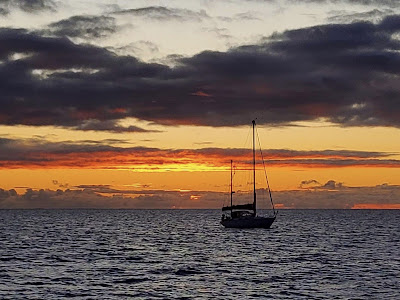The last two days of our passage to Minerva were a mix of motoring and sailing often in the company of a fleet of Chinese fishing boats.
I chose this photo as we were going quite fast. We were never less than 2 miles from the nearest and they were almost stationary.
We’re not sure what was up with their AIS as the boats were almost always pointed due north and remained in a neat ‘V’ shape as we passed through them. It was perfect squid formation; they are the synchronised swimmers of the sea. As they advance, retreat or sidle sideways they maintain the same spacial relationship to each other.
We arrived Monday around noon at low tide, dropped anchor in a bommie-free patch of sand. Bommies are rocks or coral heads in an otherwise sandy anchorage. The water is dark blue but so clear that even in 15 metres of water you can see them quite clearly with the sun at your back. You can’t, however, tell how tall they are.
Anchored as we were at low water, we relaxed in gentle winds and the smooth calm waters in protection of the outer reef.
That sliver of light brown is a portion of the reef. This photo wasn’t taken on the day we arrived. The overcast conditions seem to give more contrast. There is quite a wide border inside the visible reef that isn’t deep enough for a yacht to anchor. Getting. To get a good photo, one p might well need a drone.
This wonderful state of affairs lasted several hours until the tide turned.
As high water approached the sea state got bouncier and bouncier as the reef and its topical protection disappeared. The movement was by no means unbearable, but still enough to cause a case of mild case of the staggers should you choose to do anything other than sit.
We re-anchored to the southeast end of the reef and offered more protection even at high water from the prevailing conditions. Zoomax, who joined us there the next day, said it was MUCH better in this location.
One spends a lot of time trying to pick the perfect spot and even then, as happened the Wednesday morning, we spent a ‘fun’ hour unwrapping our chain from around an unexpectedly tall bommie when we swung around when the tide changed. Tim snorkelled and directed me from the water to go this way, that way, the other way while we untangled ourselves.
Carla on Ari B took a photo of Larus and the sunset.
It took us a little while to appreciate that you plan your daylight hours around the state of the tide. At high tide, there is some protection from the reef, but quite a lot of water does come over the top. There are always waves crashing on the outside of the reef trying to get in. It can get very lumpy and rough.
We had one walk on the reef at not quite low water and there was a steady blanket of water flowing down into the reef in sort of wide flat steps or rock and coral and pockmarked with deeper pool and puddles. The terrain was quite rough and uneven, and good foot wear is a must. It can be hard to judge the depth through the layer of water swirling across tide pools and into the dips and crannies. It is easy to miss step, which I did a number of times, and came back with some scrapes that we washed and medicated once back onboard.
Thank you, Leanne on Perigee for the gift, given back in New Zealand, of Lucas’ Papaw Ointment which contains fermented papaya. It’s coming in very useful.
We went ashore with Alex and Carla on Ari B. They are serious hunter gatherers and at low water they are often on the reef spear hunting lobster and octopus in the tide pools. They caught 6 lobsters since we arrived but the octopuses have managed to keep their heads down.
The reef is several miles across with room for quite a lot of boats. There were 15 to 20 boats during our time there. All boats that go off shore can communicate via VHS radio. They may or may not have other methods like satellite, but they always have VHS radio.
The VHS radio is kept on 24/7 while on passage and is set to Channel 16. The theory is that to chat to another boat you make first contact on Channel 16, which is the listening channel. 16 is the channel, worldwide, that you use for emergency and first contact traffic. During an emergency, the Coastguard will tell other vessels not to use 16… except in an emergency. If you are calling for a chat or to plan social events, once you have made contact, you move the conversation to a different designated channel. This is important as only one radio can transmit at a time. If you sit on Channel 16, no one else can make social, informational or emergency call.
It is also just plain irritating having to listen a pair of boats organising their amazing social lives particularly when you aren’t invited. ; )
We are just now on our way to Fiji. The sails are set and we’re going along nicely at 5.5 knots in 10 knots of wind just ahead of the beam. Light winds are forecast so we are expecting a slowish passage, but that suits us fine. We plan to arrive Monday or Tuesday so have planned the passage to take 3 or 4 days so as not to incur any overtime charges for clearing in on the weekend.
Cruisers are nothing if not frugal, and we’re not in any rush.












